Sunderland Corporation Tramways
History
Sunderland Corporation obtained powers to construct a number of standard-gauge, horse-drawn tramway lines in 1879, which were essentially extensions to the existing horse tramway, the latter being owned and operated by the Sunderland Tramways Company. These lines were opened between the 18th June 1880 and the 1st January 1881, but as municipal authorities were not permitted to operate tramways themselves — by the Tramways Act of 1870 — they were leased to the STCo.
At its maximum, Sunderland's horse tramway system extended to around 7.2 miles, circa 3.7 miles of which were owned by the corporation. There were two lines north of the River Weir, one running northeastwards from Monkwearmouth to Roker, and the other running westwards from Monkwearmouth to Southwick. The tramway crossed the river via Wearmouth Bridge, continuing southwards to Christchurch, before returning anticlockwise via Gray Road, Tatham Street and Borough Road, to Fawcett Road, where it rejoined the outward route; a branch also ran off the loop eastwards to the Docks. The circular route was crossed by two long east-west lines, one running along High Street for its entire length to Peacock Street, and the other, further south, running from Fawcett Street along Holmeside to Albion Place near the Royal Infirmary.
In 1894, the company attempted to interest the corporation in expanding the system, but naturally wanted to secure any investment it made by getting the corporation to defer its right to buy the undertaking (an option it had under the 1870 Tramways Act, from the 16th August 1899), and to give the company a blanket 21-year lease. The corporation came within a whisker of accepting the proposal, but in the end declined, beginning the long process of deciding what sort of tramway it wanted to build (namely, the method of traction, and the routes), as well as whether it wished to operate it or lease it out. On the 11th January 1899, the council formally decided to seek powers to build and operate an overhead electric system, and to serve the STCo with six months' notice of its intention to purchase the concern.
The corporation's bill received its Royal Assent on the 1st August 1899, and after some hard negotiating with the STCo, it purchased the undertaking on the 26th March 1900, taking over operation four days later on the 30th March 1900. Construction of new lines commenced in November 1899, the first electric service running on the 15th August 1900. Horse tram services continued during reconstruction, being gradually reduced as the lines were converted, the last horse service of all running on the 19th February 1901.
The final line of the corporation's new tramway — to the docks — was opened on the 23rd January 1904, taking the system to the size and form it would have for the next 20 years.
The tramway was well-run and well-maintained, and proved to be a very profitable undertaking. Like all tramway systems, the SCT suffered during the Great War from heavy loadings, loss of staff and expertise to the armed forces, and an inability to source spares, new rails or vehicles due to war-time restrictions. Unusually, however, it did manage to purchase one new tram during the conflict, but only because an existing vehicle was lost in a Zeppelin raid, along with 22 lives.
Despite the rigours of post-war inflation, which was followed by a severe economic downturn, the corporation managed to find the money to reinvigorate the run-down system, renewing track and updating the ageing tramcar fleet. The latter was achieved through a mixture of new purchases, new builds and rebuilding, which continued right through the 1920s and 1930s, the last new car arriving in 1940. In addition, the SCT cannily purchased modern tramcars from systems that were closing down, acquiring a significant number of such vehicles in the 1930s and 1940s at knock-down prices, the last of these as late as 1947.
The corporation's commitment to the tramway resulted in a significant expansion of the system, as lines were built to new housing estates, enabling the tramway to continue serving the population as it migrated away from the centre of the town. A new line was built along Durham Road to Barnes Park, which opened in late 1925, was extended no less than three times: to Hambledon Hill in 1929, to Grindon Lane in 1948 and Thorney Close Road in 1948. In addition, the Fulwell line was extended eastwards to Seaburn in 1937. During this period of expansion, there was one closure — the loss-making docks branch in 1928 — a line which always struggled for patronage, and which probably should never have been built, especially given the fact that the SCT's predecessor (the STCo) had also failed to make it pay. The docks line was replaced by a bus service, the corporation's first, having only acquired the powers to run motorbuses in 1927.
In 1929, the SCT's tramway manager died, being replaced by the manager of Wigan Corporation Tramways and Motors, where he had been instrumental in transitioning services away from trams and trolleybuses to buses. His appointment gave the rather vocal anti-tram lobby in Sunderland reason to rejoice, though it was to prove extremely short-lived, as his assessment of the system resulted in a recommendation to retain the tramway and modernise it. He clearly saw Sunderland, with its compact and densely populated districts as ideal tramcar territory, the tramcar being unrivalled in moving large numbers of people over relatively short distances. The council accepted the recommendation, the entire enterprise being thoroughly reorganised and modernised, a process that included much experimentation with tramcar design and operation.
The tramway was of course not operated in isolation, and throughout the 1930s, the network of bus services was continually expanded, especially out to newly built housing estates, the name of the enterprise being changed in 1937 — to Sunderland Corporation Transport — to better reflect the services delivered.
By the onset of the Second World War, Sunderland possessed one of the most modern and efficient tramway systems in the British Isles, a situation that was to see it well placed to continue serving the public through the rigours of wartime. The end of the war, however ,brought a new world, one which it was clear would be dominated by the private motor vehicle, and with this in mind, the manager recommended a gradual abandonment of the tramway system in favour of buses. Although the council formally adopted this policy on the 11th January 1947, there was to be no sudden death, with the Durham Road line being extended twice after this date, though almost certainly because new buses were difficult to obtain at the time.
The first tramway line closed on the 5th November 1950 and the last of all — Seaburn via Fulwell — nearly four years later on the 1st October 1954.
At its maximum, Sunderland Corporation's electric tramway system totalled 13.73 miles, with three lines to the north of the River Weir and five lines to the south, connected via Wearmouth Bridge. In the north, lines ran from Monkwearmouth westwards to Southwick; northwards to Fulwell then eastwards to Seaburn; and northeastwards to Roker then northwards along Whitburn Road to Sea Lane. South of the river the tramway ran along Bridge Street and Fawcett Street to its junction with Borough Road, from where lines ran to the east, south and west: to the south along Burdon Road to Grangetown; to the east, clockwise along Borough Road, Tatham Street (where a branch ran eastwards to the docks) and Suffolk Street to Villette Road, where it rejoined the Grangetown line; and to the east, clockwise via Western Hill, Chester Road, Kayll Road, Hylton Road and High Street West to join the Bridge Street line (this line was dubbed 'The Circle'). Lastly, a long line branched off 'The Circle' at Southill Crescent, running southwestwards along Durham Road to Thorney Close Road.
Whilst several attempts were made to connect the system to South Shields Corporation Tramways to the north, all failed, primarily due to the respective municipal authorities' inability to agree on the course of a connecting route. At the south end of the system (at Grangetown), the corporation's tracks met those of the Sunderland District Electric Tramways, which opened its newly-built line from Houghton-le-Spring on the 10th June 1905. Despite requests to connect the tracks and overhead in order to run through services, the corporation turned the company down flat, almost certainly on idealogical grounds. Through services were, however, eventually initiated some 16 years later on the 3rd January 1921, the corporation's attitude softening in the face of increasing bus competition, which had the advantage of not requiring the public to change vehicles at Grangetown. The agreement saw S&DET cars run through to the Gas Office in Burdon Road and Sea Lane (the latter on specials rather than regularly), with SCT cars running through to Ryhope; all this was, however, to be short-lived, the last S&DET service to the Gas Office being withdrawn on the 12th March 1925, the company completing its switch from tramcar to bus operation in July that year, and abandoning its tramway.
Uniforms
Sunderland Corporation took over operation of the horse tramway from the erstwhile Sunderland Tramways Company on the 30th March 1900, continuing to operate the horsecars until withdrawal of the final service on 19th February 1901. It is currently unclear whether the corporation saw fit to issue the men working these services with new uniforms, or whether they simply continued to wear the uniforms they had worn previously.
Although early photos depicting tramway staff working the new electric services are rare, those that have survived clearly show that both motormen and conductors wore single-breasted jackets with five buttons (bearing the assumed arms of Sunderland and the full system title — see link), plus two buttons on each cuff, two waist pockets, a breast pocket (on the left-hand side) and stand-up collars; the latter do not appear to have borne any kind of insignia. The uniform was dark blue in colour. Drooping-peak caps were worn, which carried a script-lettering cap badge — either 'Conductor' or 'Motorman' — together with a small badge of unknown pattern. The cap badges appear to have been replaced — probably in 1901 or 1902 — by an elaborate oval cap badge (nickel), comprising: the assumed arms, within a garter containing the full system title ('SUNDERLAND CORPORATION TRAMWAYS'), all surrounded by a wreath.
The early style of jackets was superseded — around 1905 — by double-breasted, lancer-style tunics with five pairs of buttons — narrowing from top to bottom — epaulettes and stand-up collars. The collars appear to have carried a small municipal-device badge, though precise details are unclear; the epaulettes carried a staff number in metal numerals and a small municipal-device badge (not always present), and were fastened at the neck end with a button. At the same time, the caps were changed to a peaked type with a tensioned crown (top); they carried a completely new cap badge comprising the municipal device, above a ribbon bearing the legend ‘SUNDERLAND TRAMS’ (see below). The badge was presumably re-designed because its predecessor, which was rather tall, would either not have fitted on the new caps, or would have looked somewhat awkward. The badges and buttons were probably brass initially (1900-1902), though these appear to have been relatively quickly displaced in favour of nickel. The lancer-style jackets were probably issued right through to the 1930s, when they were superseded by double-breasted jackets with four pairs of buttons, two waist pockets, and lapels; photographs suggest that these appeared both with and without epaulettes (at different time points). The lapels carried a staff number, whilst the piped epaulettes (when present) bore the small municipal-device badge previously applied to the stand-up collars.
From 1937 onwards, when the name of the undertaking was changed to Sunderland Corporation Transport, new issues of uniforms and caps would have carried 'Transport' insignia. The new cap badge was similar in form to its predecessor, but with an altered municipal device and 'TRANSPORT' instead of 'TRAMS' in the ribbon below; the material was initially nickel, but at some point was changed to chrome. Towards the end of the system's life, the caps were changed to a soft-topped peaked design, and whilst the jackets remained double-breasted, the style was subtly altered to a piped design with epaulettes.
Staff were also issued with long, double-breasted greatcoats with five pairs of buttons, high fold-over collars and epaulettes (see below); it is unclear what badges, if any, these garments bore.
A photograph taken on the last service from Seaburn (see below), shows the motorman wearing an unmarked, round PSV-like badge/number, the precise purpose of which is unknown. This badge appears, however, to only have been used very late in the tramway system's life.
By 1905, inspectors were wearing a traditional style of tramway inspector's uniform, comprising a single-breasted jacket with hidden buttons (or more likely a hook and eye affair) with slit pockets — all edged in a finer material than the main body — and with stand-up collars; the latter probably bore 'Inspector' in embroidered script lettering. Caps were in a drooping-peak style and bore a small brass cap badge incorporating a stylised municipal device with 'SUNDERLAND' in block captials within a curved ribbon underneath, (see below for an example); this was worn above a hat band that again bore the grade — 'Inspector' — in embroidered script lettering. At some point, the cap was changed to a more modern peaked type with a tensioned crown; the brass cap badge was also changed, possibly as late as 1937, to a new nickel pattern, still based on the muncipal device, but lacking the ribbon and title of its predecessor. At the end of the system's life, inspectors were wearing smart single-breasted jackets with four buttons, four pockets (with button closures), waist belt, epaulettes (also with button closure) and lapels; the upper part of the latter (the collars) bore the grade — 'Inspector' — in embroidered script lettering.
In common with many other UK tramway systems, women were employed in significant numbers during the Great War, both as conductresses (referred to as lady conductors), motorwomen (lady drivers) and inspectresses. The first conductresses started on the 9th June 1915. Eventually, all 85 conductors were female, the last one being discharged in 1920. Female tramcar staff were issued with long skirts and long, single-breasted jackets with five buttons, a waist belt (with two buttons), hip and breast pockets, fold-over collars and epaulettes; the latter probably carried the same insignia as the corresponding male tunics. Headgear took the form of a baggy cap with a glossy peak, usually referred to as a 'motor cap'; these bore the standard SCT cap badge. The ladies were also issued with what would appear to be the standard greatcoat worn by male staff, i.e., untailored for the female form. Great War lady inspectors wore identical uniforms to female tramcar staff, but with the standard cap badge replaced by an inspector's badge and a grade badge; it is unclear whether the latter was embroidered or in metal.
Female staff were also employed during the Second World War, both as conductresses and as motorwomen. These ladies were issued with 'air force blue' uniforms, comprising: modern knee-length skirts and tailored, single-breasted jackets with breast and hip pockets (both with button fastenings), a waist belt and epaulettes. The only insignia used on ladies’ tunics appears to have been on the epaulettes, with the exception of lady inspectors, who had ‘Inspector’ in embroidered, script lettering on the upper lapels of their jackets. Caps were similar to those worn by male staff, but were slightly floppier in appearance, though they still carried the standard cap badge.
Further reading
For a detailed history, see: 'Tramways of Sunderland' by S A Staddon; Advertiser Press (1964). A second, and heavily revised edition was published by the Sunderland Echo (1991).
Images
Motormen and conductors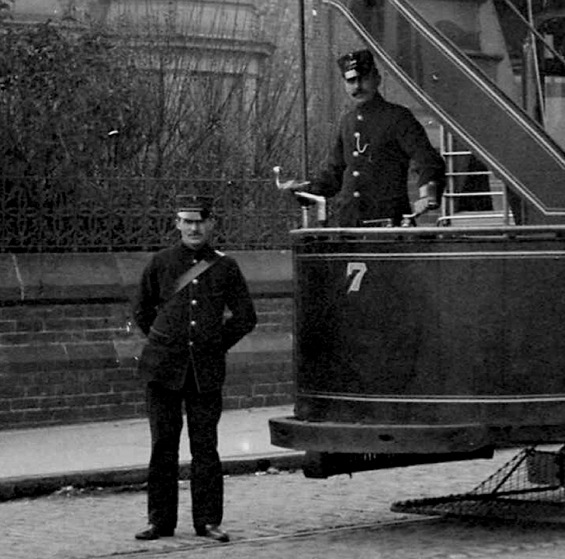
The crew of Tramcar No 7, which is about to reverse over the cross-over at the terminus at the south end of Roker Terrace, on the short working to High Street (Mackies Corner) — photo undated, but believed to have been taken in September 1900. The drooping-peak caps carry script-lettering grade badges beneath another small badge. With thanks to Malcolm Fraser.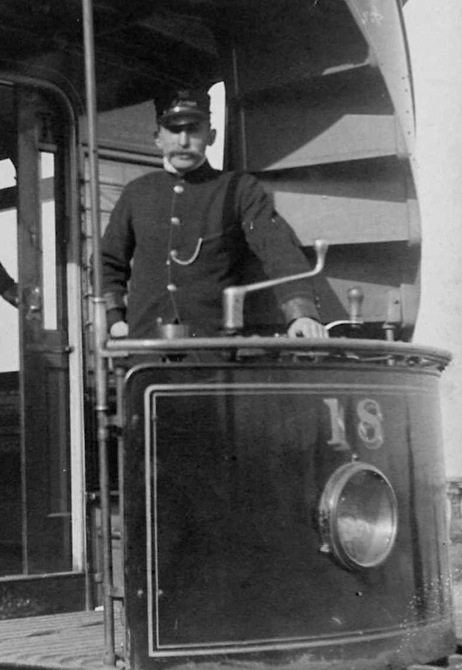
A motorman aboard Tramcar No 18, which is facing south at Roker Terrace. This shot is thought to have been taken in March 1901 as the car was only delivered in the previous December (with bogie trucks), all of which had been replaced by the spring of 1901; this is the only known photo of one of these bogie cars in unmodified condition. With thanks to Malcolm Fraser
Brass, script-lettering cap badges of the type worn by Sunderland Corporation Tramways staff in the early years of operation. Author's Collection.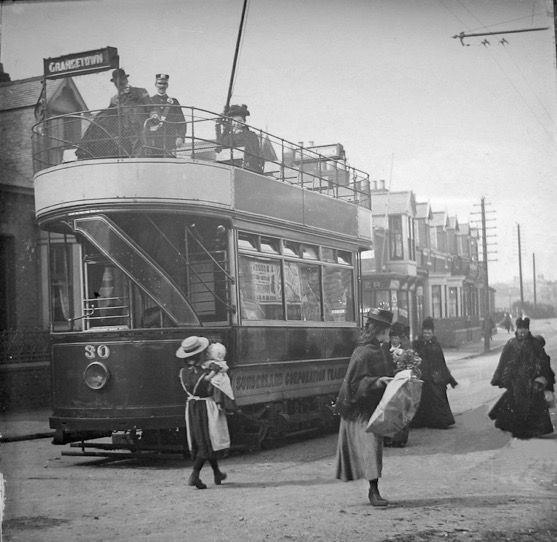
SCT open-top tramcar No 30 at the Grangetown terminus on Ryhope Road — photo undated, but probably taken around 1902. With thanks to Malcolm Fraser.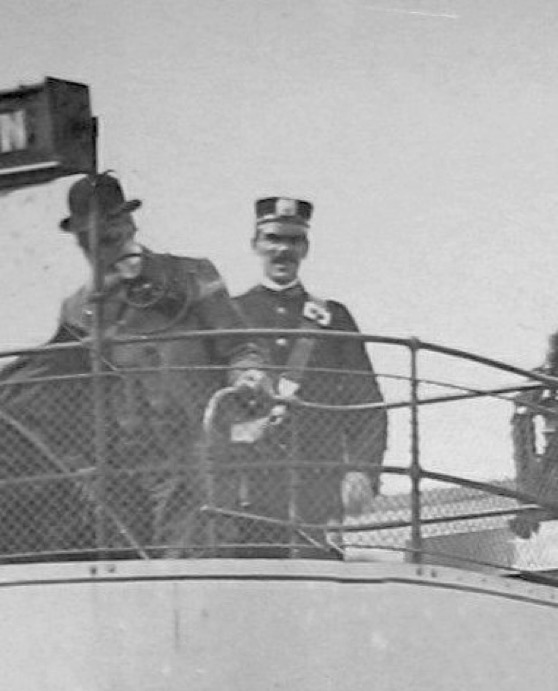
An enlargement of the above photograph showing the conductor, who is wearing a drooping-peak cap that bears a tall oval cap badge (almost certainly the pattern illustrated below).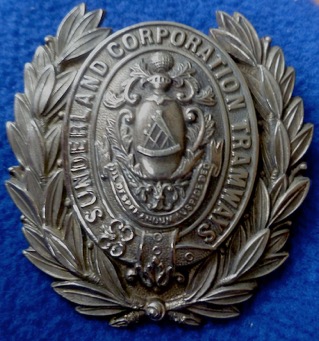
Sunderland Corporation Tramways cap badge — nickel. This badge is probably the same pattern as seen in the 1902 photo above. It appears to have replaced the script-lettering grade badges (probably in 1901 or 1902), but was itself superseded with the switch to tensioned-crown peaked caps (around 1905); this may have been because it would probably have been too tall for the older caps. Author's Collection.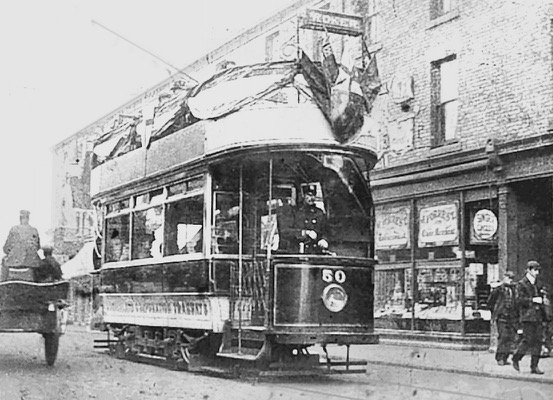
A poor-quality photograph showing a motorman with the new style of cap badge, but one which can be reasonably accurately dated as the tram has been decorated to celebrate the coronation of Edward VII and his wife Alexandra, which took place on the 9 August 1902. With thanks to Malcolm Fraser.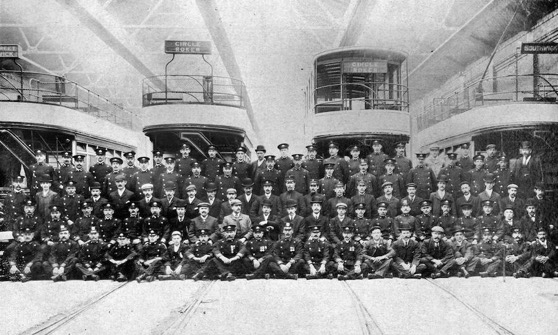
A staff photo taken at the Hylton Road Depot in 1905. With thanks to Malcolm Fraser.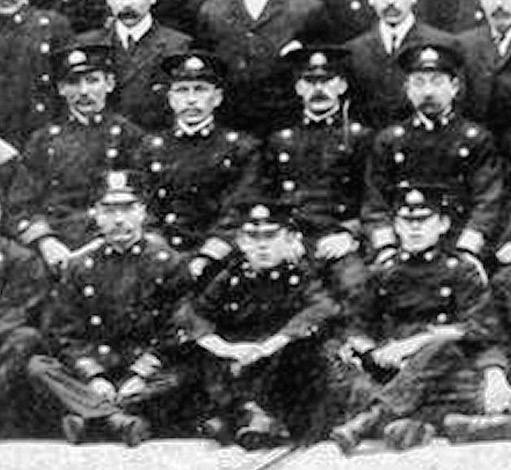
An enlargement of the above photograph, showing some of the staff. Whilst the majority of those depicted in the photo are wearing tensioned-crown peaked caps, bearing a new type of cap badge (see below), several individuals are wearing the older drooping-peak caps with the taller badge.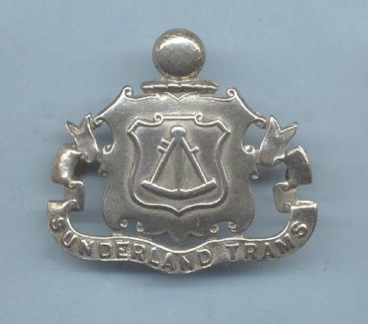
Sunderland Corporation Tramways cap badge — nickel. This style of badge appears to have been worn from around 1905 to circa 1937, when the name of the undertaking was changed to Sunderland Corporation Tramways. With thanks to Stephen Howarth.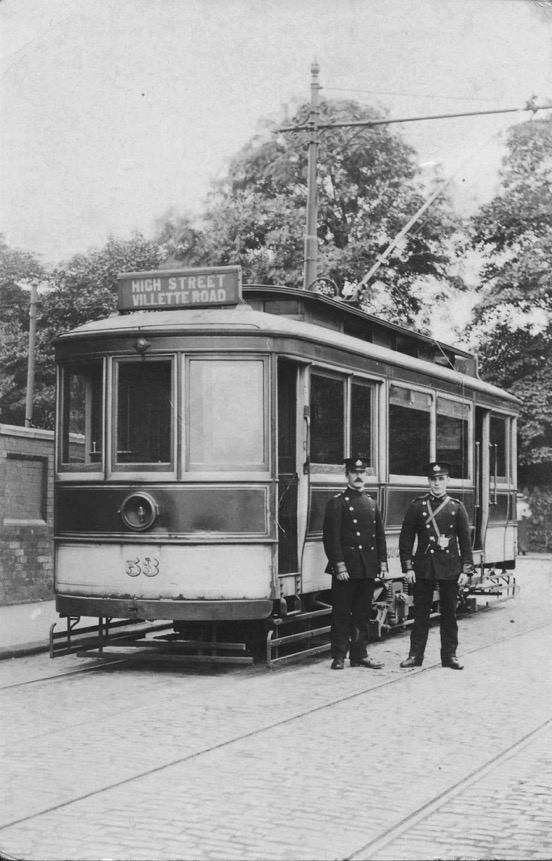
Combination Tramcar No 53 standing at the Villette Road terminus with its crew — photo undated, but probably taken around 1906. Source unknown.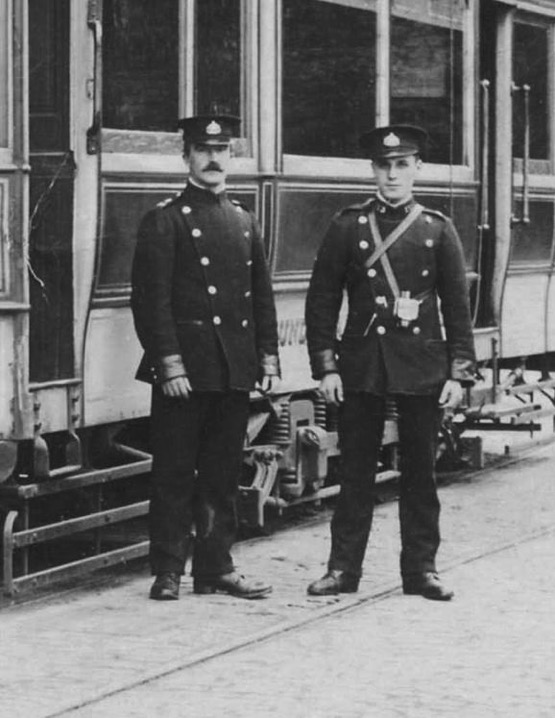
An enlargement of the above photograph showing the motorman and the conductor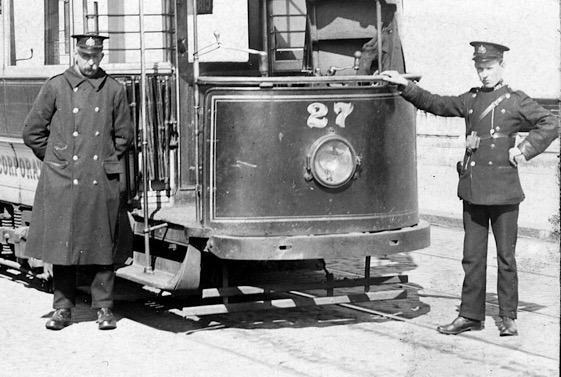
A motorman and a conductor pose with Tramcar No 27 — on the Roker Circle route — at Roker Terrace; photo undated, but probably taken around the time of the Great War. Image kindly supplied by Beamish Museum Limited (see link), image copyright Beamish Museum Limited.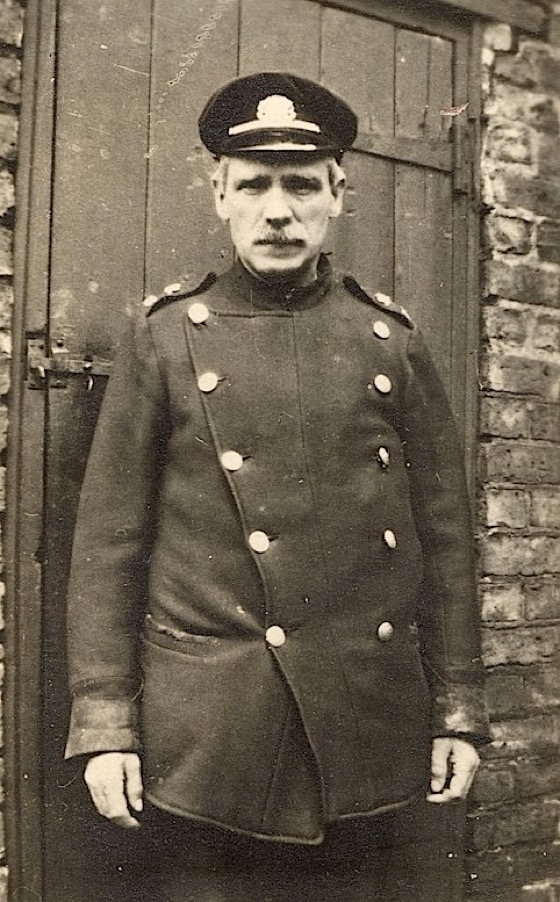
A Sunderland Corporation Tramways employee, probably a motorman, pictured rather prosaically outside his outhouse — photo undated, but possibly taken around the time of Great War or in the 1920s. Author's Collection.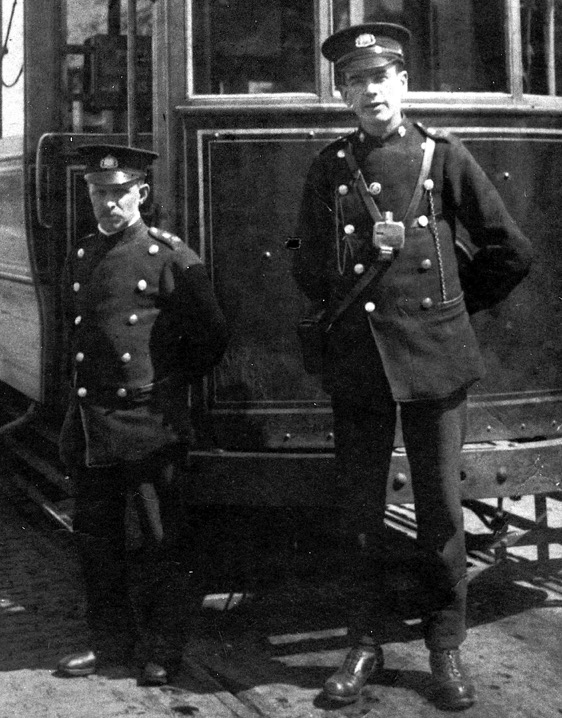
A motorman and a conductor pose with Tramcar No 52 on Villette Road, photo taken in 1922. Image kindly supplied by Beamish Museum Limited (see link), image copyright Beamish Museum Limited.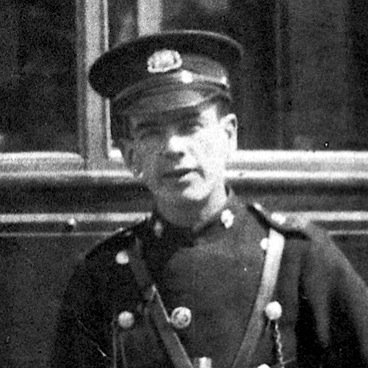
An enlargement of the above photograph showing the cap badge, collar and epaulette insignia (button, staff number and shield badge).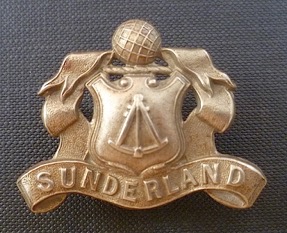
Possible SCT epaulette badge — nickel. Author's Collection.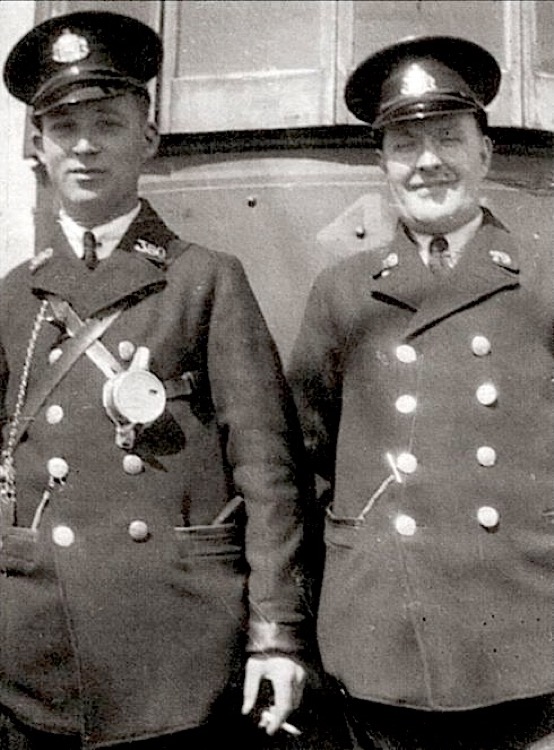
Conductor Bob Richardson (Employee No 360) and his motorman (Employee No 79) pose in front of their tramcar — photo undated, but probably taken in the mid 1930s given that these balcony cars, with their 5-panel windscreens, had all been scrapped by 1938. With thanks to Malcolm Fraser.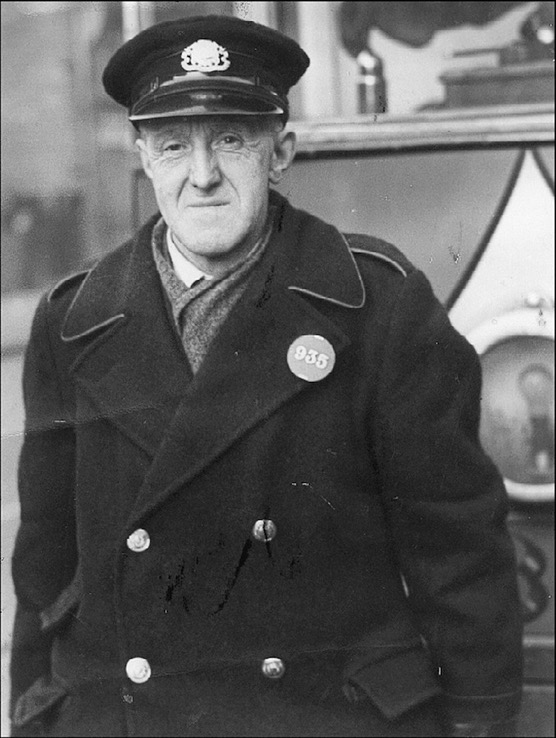
Motorman Roger Pickering in front of ex-Bury Tramcar No 85, with the last service to leave the terminus at Seaburn when the Circle route closed on the night of Sunday 3rd January 1954. It was a wild night and the rain poured down as No 85 arrived at the terminus, crewed by the aforementioned Mr Pickering and conductress Mrs Sally Rooks; it also carried a Sunderland Echo reporter. When it set off again, the only fare-paying passenger (and the last one of countless thousands to travel home along the sea front) was 18-year old Malcolm Fraser, to whom I am indebted for this information. Thanks also to Stephen Howarth for drawing my attention to the photo.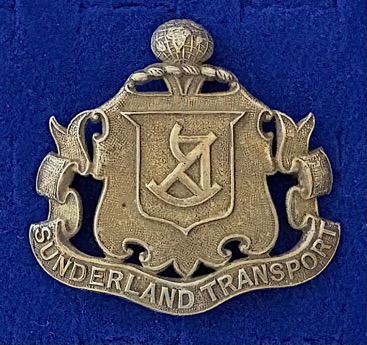
Sunderland Corporation Transport cap badge — nickel. This style of badge was probably issued from around 1937 onwards, when the name of the undertaking was changed to Sunderland Corporation Transport. Author's Collection.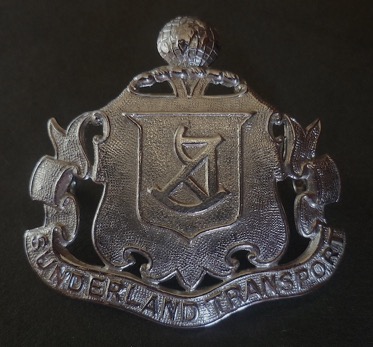
Sunderland Corporation Transport cap badge — chrome. Badges in this material probably replaced those in nickel in the 1940s or 1950s. Author's Collection.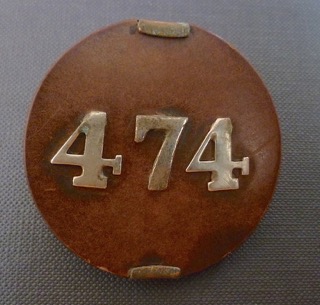
SCT employee number or licence badge, of the type clearly seen on the preceding photo. This particular example was worn by James Edward Hagan, who worked on the Sunderland Corporation Transport buses around 1959/60. Author's Collection.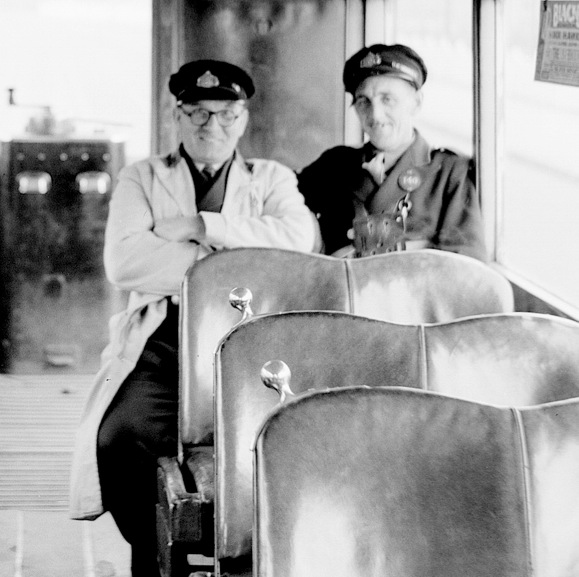
A motorman and a conductor (Employee No 140) pose for the camera of M J O'Connor in the interior of Tramcar No 87 at Seaburn — 1st September 1954 — both wearing soft-topped peaked caps. With thanks to the National Tramway Museum. 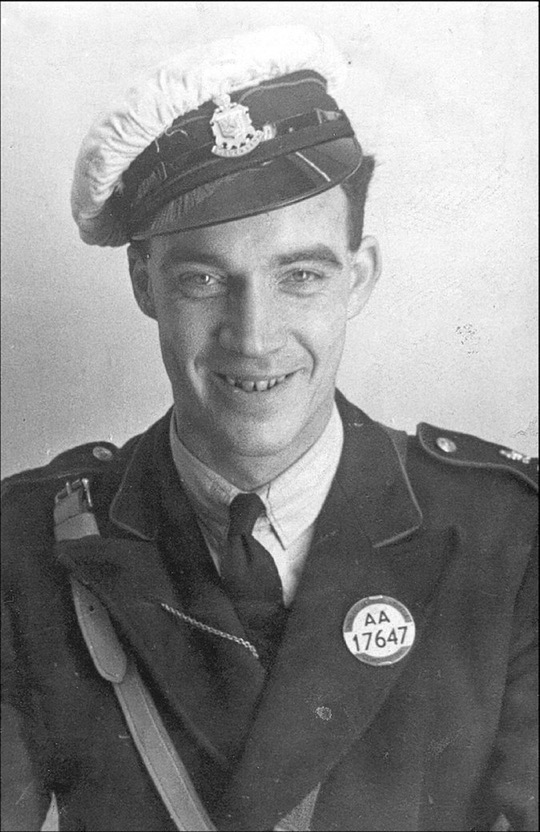
Sunderland Corporation Transport bus conductor Cyril Pace — photo undated, but probably taken in the 1940s. With thanks to Malcolm Fraser.
Senior staff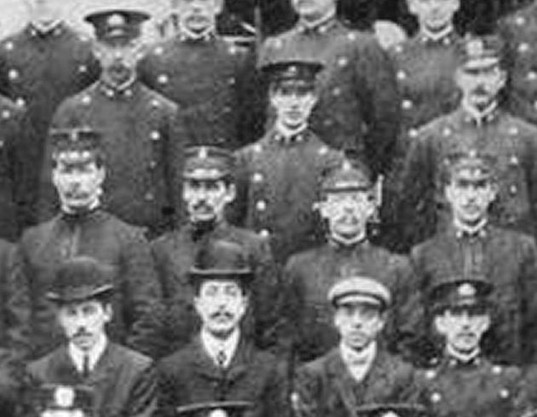
An enlargement of the 1905 depot photograph above showing some of the inspectors, who all appear to be wearing fairly typical 'tramway inspector' garb, along with drooping-peak caps that bear a small cap badge and a grade badge (the latter in embroidered script lettering).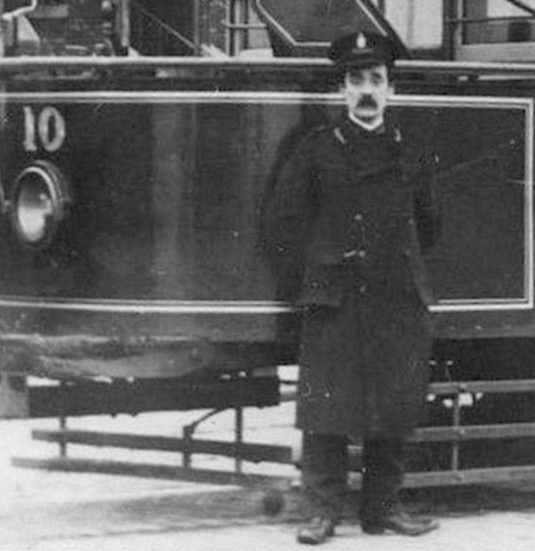
A rare shot of an SCT inspector — photo taken in 1913 at the Roker terminus, towards the southern end of Roker Terrace, with Tramcar No 10 in the background, a vehicle which was to have the dubious distinction, three years later, of being destroyed by a Zeppelin airship. Photo and background information kindly supplied by Malcolm Fraser.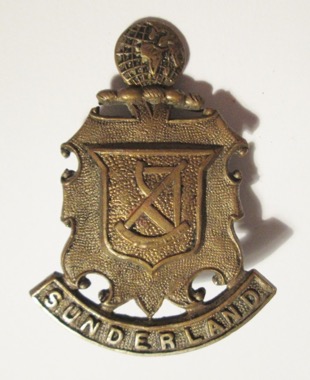
An example of what is, in all probability, an early Sunderland Corporation Tramways senior staff cap badge — brass. Photo courtesy of the Stephen Howarth Collection.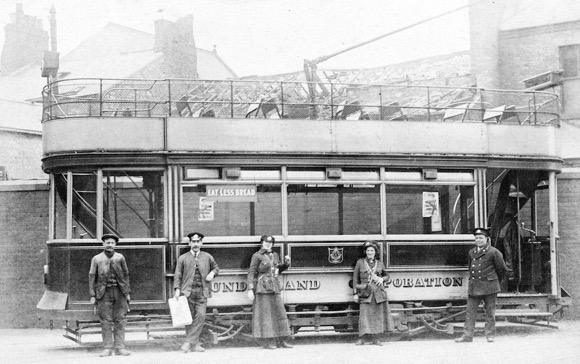
An unidentified tramcar with depot staff, conductresses and a senior staff member (?) in the Wheatsheaf depot yard in April 1916. This photograph was taken just after Tram No 10 was destroyed by Zeppelin L11 (see damage to buildings behind the tram). Photo and background information kindly supplied by Malcolm Fraser.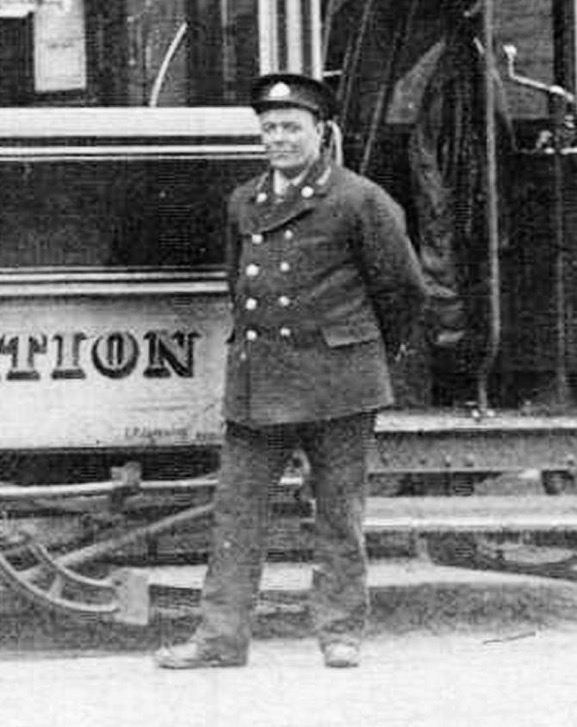
An enlargement of the above photograph showing an individual who may be senior staff member (foreman?); no other photos from this era show this jacket, or collar insignia (these suggest a senior grade), though the cap badge appears to be of the standard pattern.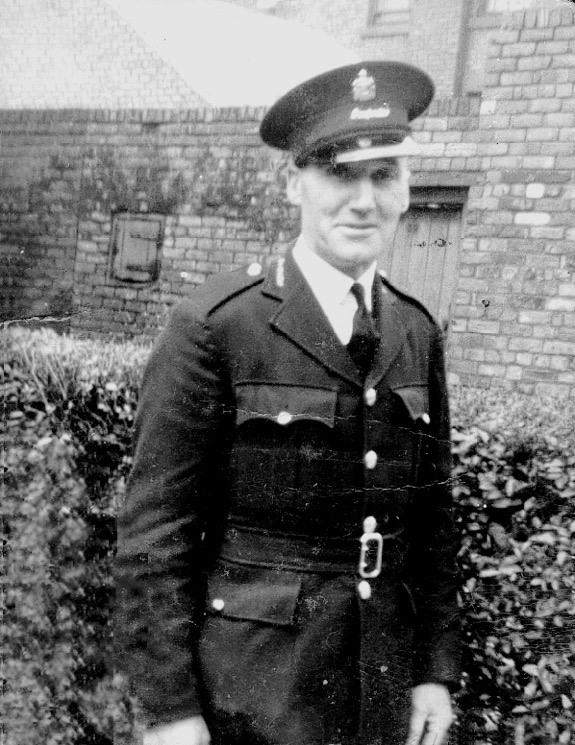
Bob Nesbitt, ready for his first day as an inspector on Saturday 7th August 1947; he eventually retired some 28 years later as a Divisional Inspector in 1975. The cap badge differs notably from that worn by senior staff earlier in the system's life. With thanks to his son John Nesbitt for the background information, and Malcolm Fraser for the photograph.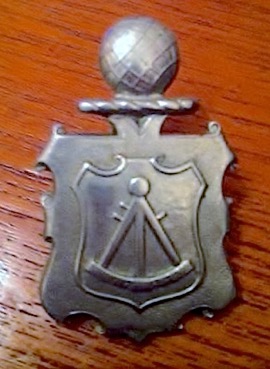
An example of the second style of senior staff cap badge, lacking the title and ribbon at the base of the earlier badge — nickel. It is unclear when this badge was introduced, though 1937, when the name of the undertaking was changed to Sunderland Corporation Transport, would be a reasonable candidate. Photo courtesy of the Stephen Howarth Collection.
Female staff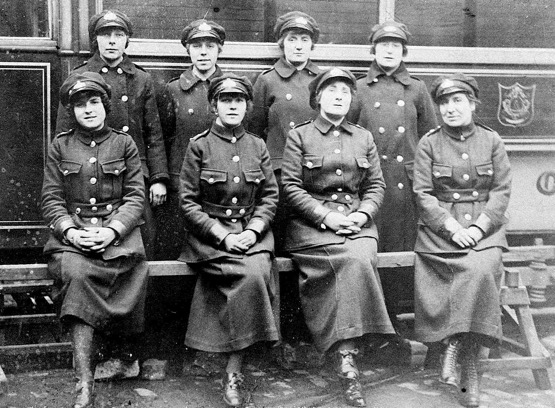
A nicely posed photo of female tramway staff — undated, but almost certainly taken during the Great War. The lady on the front row at the left is Jean Newton (see below), and at the back, third from the left is Annie Goodhall (see also below). Image kindly supplied by Beamish Museum Limited (see link), image copyright Beamish Museum Limited.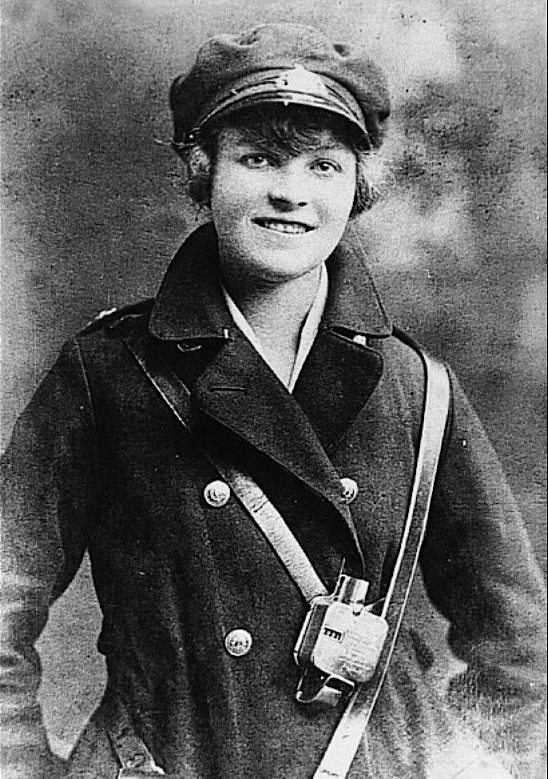
Conductress Jean Newton — photo dated 1916. With thanks to Malcolm Fraser.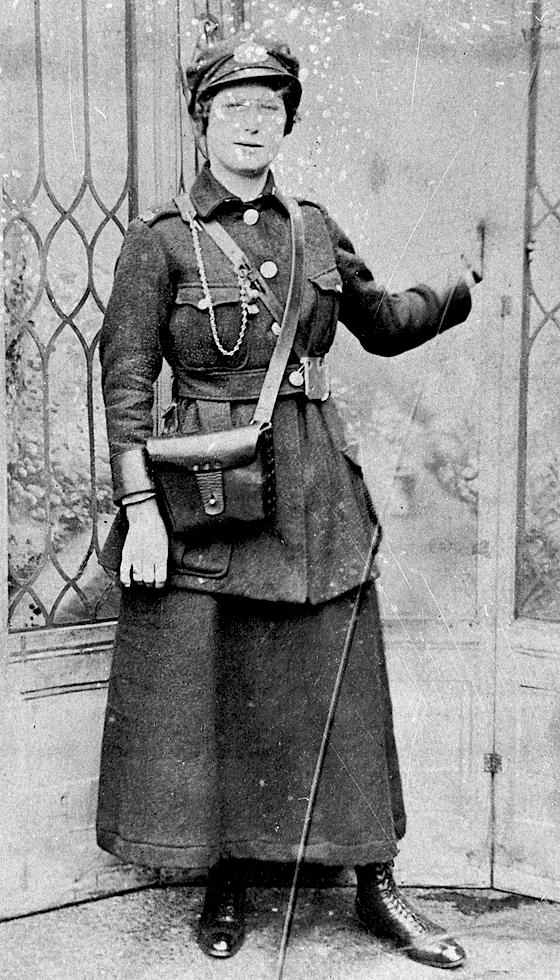
A studio portrait of conductress E Rooke — photo undated, but almost certainly taken during the Great War. Image kindly supplied by Beamish Museum Limited (see link), image copyright Beamish Museum Limited.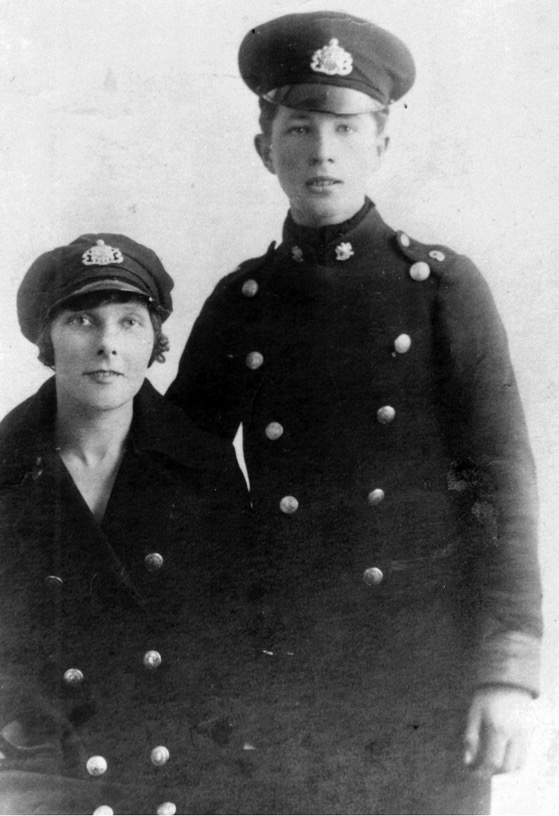
Motorwoman Annie Goodall, pictured together with a points boy (Employee No 9) in 1918. With thanks to Malcolm Fraser.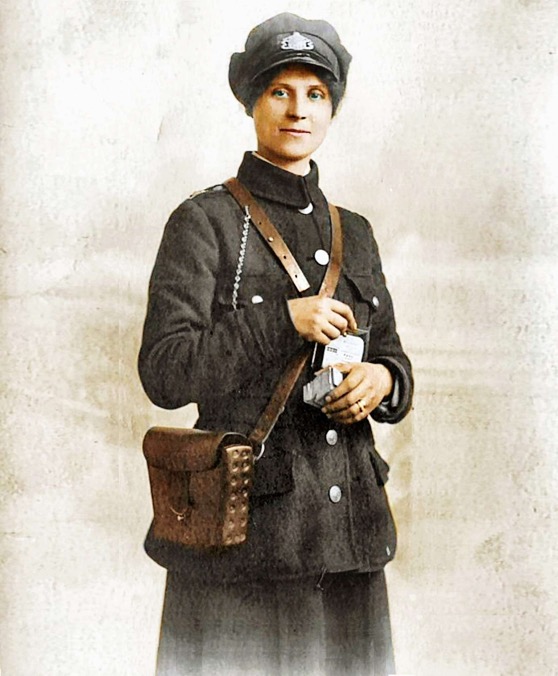
A digitally colourised photograph of an SCT conductress— photo undated, but certainly taken during the Great War or shortly afterwards. Photo courtesy of the Stephen Howarth Collection.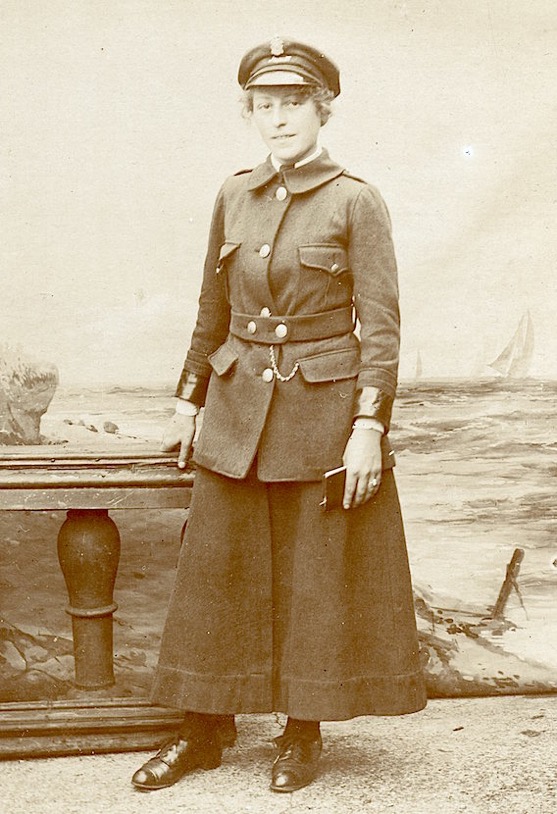
An evocative studio portrait of a Sunderland Corporation Tramways Great War lady inspector. Author's Collection.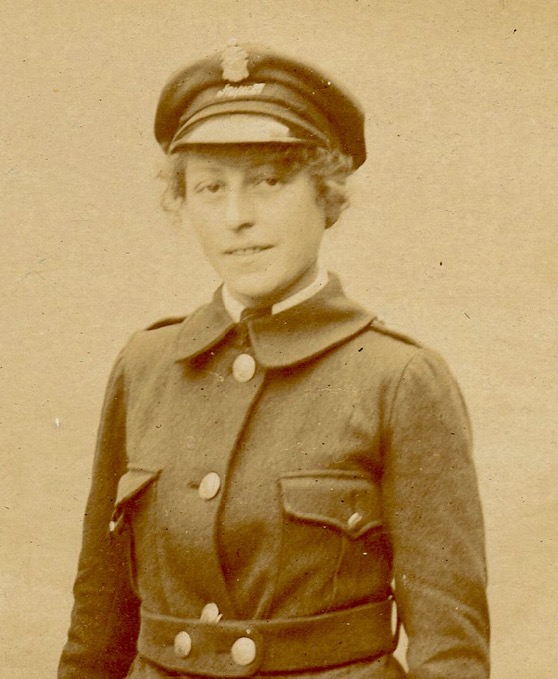
An enlargement of the above photograph, revealing the cap badge to be the same as that worn by male inspectors.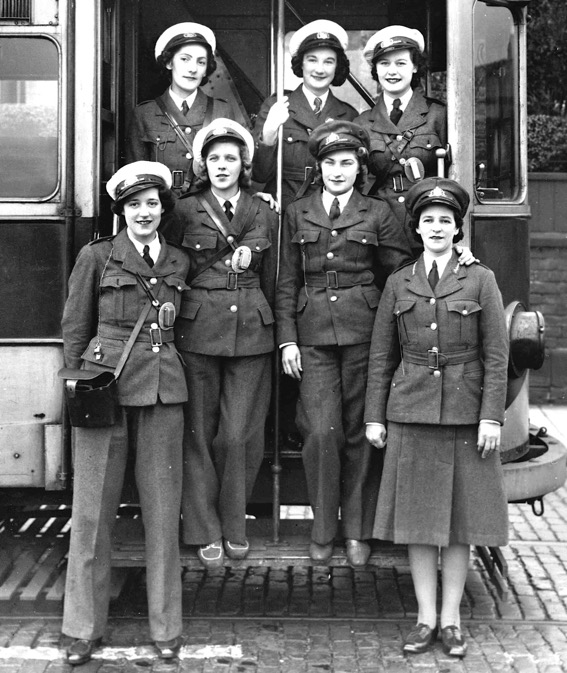
A particularly evocative photo of lady conductresses aboard a tramcar platform during the Second World War. The lady at the right (front) is Inspector Muriel Newton. Image kindly supplied by Beamish Museum Limited (see link), image copyright Beamish Museum Limited.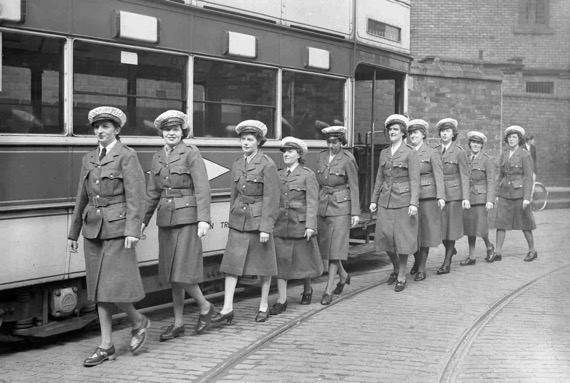
The first batch of conductresses recruited during the Second World War troop past one of the eight tramcars purchased from Huddersfield — photo taken on Tuesday 23rd July 1940 in Wheat Sheaf depot yard. With thanks to Malcolm Fraser.